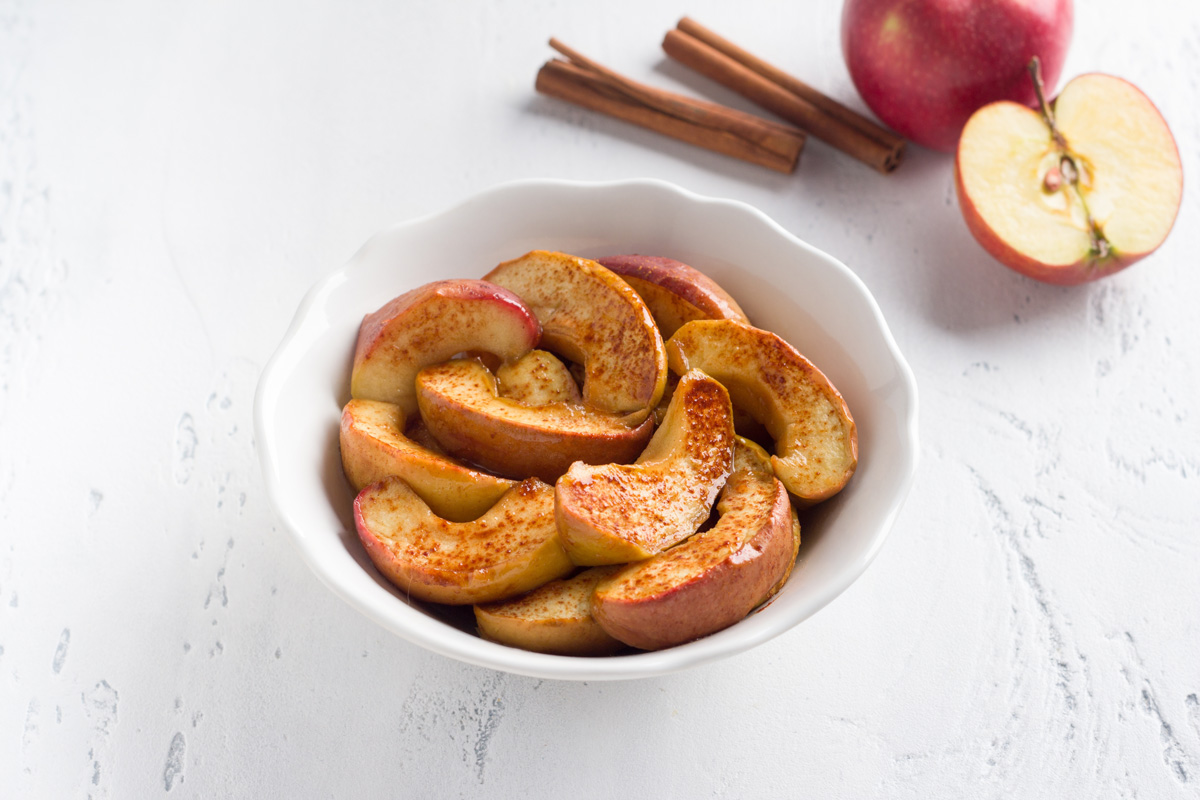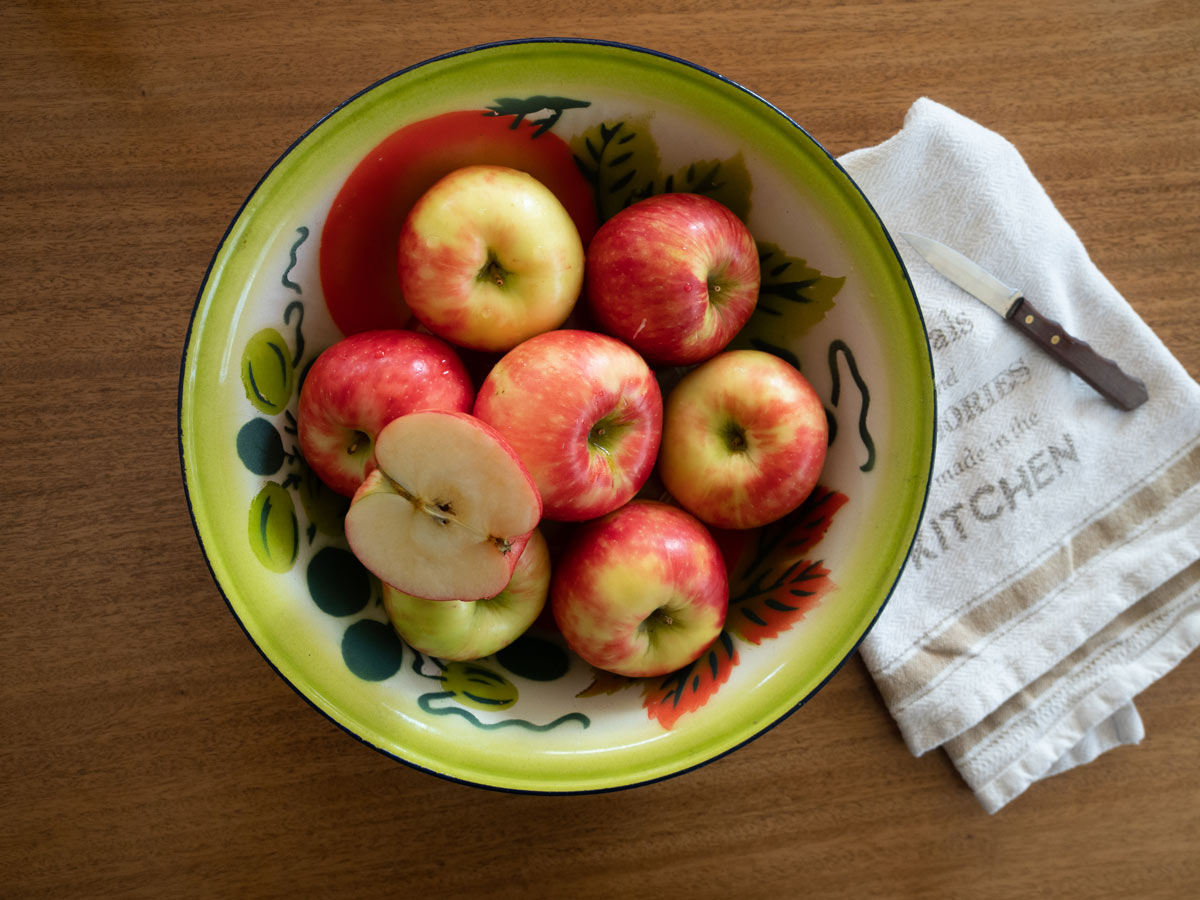“Spiked” Apples Recipe, Spotlight on Apples, The Paring Knife, Cutting Calories May Boost Longevity, and Do You Have Aging Anxiety? Another Reason to Exercise!
If you’re like me, you love recipes that can be adapted to many dishes—and that’s why spiked apples are part of my winter repertoire. You’ll be tempted to eat them right out of the pan, but you should definitely explore the ways they can enhance other dishes. I’m also sharing two new discoveries—why just a small cut in daily calories can add years to your life and what you can do to quell anxiety over aging.
“Spiked” Apples
 “Spiked” Apples
“Spiked” ApplesCalvados, the apple brandy from France’s Normandy region, adds great depth of flavor to apple dishes. Since most of the alcohol burns off, my spiked apples make a great addition to your morning oats or yogurt as well as a delicious filling for a tart or crêpes or the topping for a scoop of ice cream—vanilla and olive oil ice cream, of course! They’re equally delicious served alongside pork chops or a pork roast.
Ingredients
- 4 tablespoons extra virgin olive oil
- 2 tart apples, such as Granny Smith, cored and sliced into 12 wedges
- 2 sweet apples, such as Fuji or Honeycrisp, cored and sliced into 12 wedges
- 1/4 cup calvados
- 1/4 cup brown sugar or your choice of sweetener
- Cinnamon to taste
- 2 tablespoons unsalted butter
Directions
Heat a large frying pan over medium heat. When very warm, add the olive oil and the apples, arranging the fruit in one layer (do this in batches if your pan can’t hold them all at once). Let the apples cook until the edges brown slightly, then flip them and brown again. Add the calvados to deglaze the pan. After one minute, sprinkle on the brown sugar and cinnamon and toss. The sugar should melt, but don’t let it burn. Add the butter and swirl until it melts, then remove from heat.
Yields 4-6 servings

Healthy Ingredient Spotlight
Apples Galore

There’s merit to the old adage that an apple a day keeps the doctor away—high in fiber and nutrients, apples are a great way to get you closer to the recommended daily five to seven servings of fruits and vegetables needed for good health. With over 2,000 varieties of apples now available and more being developed at leading agricultural universities, it would take years to try them all! Here are some of the most widely available varieties and how best to enjoy them.
- Empire: a sweet-tart cross between Red Delicious and McIntosh, ideal for eating raw or baking
- Fuji: crispy, sweet, and juicy, ideal for all uses
- Gala: crisp, juicy, and very sweet, ideal for eating raw
- Golden Delicious: mild, sweet flavor, ideal for eating raw or baking
- Granny Smith: tart and crisp, ideal for salads or cooking
- Honeycrisp: sweet and crispy, ideal for eating raw or making applesauce
- Jonagold: a sweet-tart mix developed from Golden Delicious and Jonathan apples, ideal for baking
- Macoun: very sweet, juicy, and aromatic, ideal for eating raw or making applesauce
- McIntosh: tangy and tart, ideal for eating raw or making applesauce
- Pink Lady: a highly flavorful cross of Golden Delicious and Lady Williams apples, ideal for all uses
- Red Delicious: sweet, crispy, and juicy, ideal for eating raw

Quick Kitchen Nugget
The Paring Knife

With all the stunning types of chef’s knives available, the chef’s knife’s sidekick, the paring knife, is often an afterthought in the kitchen. But it’s a very handy knife to have for precision work and when cutting smaller and soft foods, from a garlic clove up to an apple. (You’ll need to stick to your chef’s knife for hard foods like squash, potatoes, carrots, and melons.) A paring knife blade is typically between 3 and 4 inches long, and though the handle is smaller than that of other knives, you should still test it before you buy to make sure it feels comfortable in your hand.

For Your Best Health
Cutting Calories May Boost Longevity
Calorie restriction—decreasing daily calories—without depriving yourself of essential vitamins and minerals and other key nutrients has long been known to delay the progression of age-related diseases in animal studies. New research, published in the journal Aging Cell, suggests it may do the same for people.
Researchers at the National Institutes of Health and colleagues analyzed data from the Comprehensive Assessment of Long-Term Effects of Reducing Intake of Energy (CALERIE), a study supported by the National Institute on Aging (NIA). For CALERIE participants, the goal was to reduce daily calories by 25%. However, over a two-year span, the best they were able to achieve was a 12% reduction. But it turns out that this was enough to rejuvenate muscle and activate key biological pathways that are important in healthy aging.
“A 12% reduction in calorie intake is very modest,” said corresponding author and NIA Scientific Director Luigi Ferrucci, MD, PhD. “This kind of small reduction in calorie intake is doable and may make a big difference in your health.”
The research team also sought to explain a finding of past studies: People practicing calorie restriction lost muscle mass (along with losing weight in general), but they did not lose all-important muscle strength. To understand this phenomenon, they looked at thigh muscle biopsies from CALERIE participants collected when people joined the study and at one-year and two-year follow-ups. They discovered that during calorie restriction certain genes were upregulated, meaning the cells made more mRNA, and others were downregulated, meaning the cells produced less mRNA. Specifically, a lower caloric intake upregulated genes responsible for energy generation and metabolism and downregulated inflammatory genes, leading to lower inflammation.
“Since inflammation and aging are strongly coupled, calorie restriction represents a powerful approach to preventing the pro-inflammatory state that is developed by many older people,” said Dr. Ferrucci.

Fitness Flash
Do You Have Aging Anxiety? Another Reason to Exercise!
According to Sarah Francis, PhD, Iowa State University professor and Jane Armstrong Endowed Chair of Food Science and Human Nutrition, many people experience aging anxiety—fears and concerns about losing autonomy and relationships as well as physical and psychological changes and discomfort or lack of enjoyment being around older people. “Previous research has shown that if you have high anxiety about aging, you have poor health outcomes. But if you view it more positively as a life stage, you have better health outcomes. You’re more likely to make lifestyle changes that benefit you in the long run,” said Dr. Francis.
Since 2010, she has been part of a USDA multistate project bringing together experts in physical activity, clinical nutrition, and community health programming to support healthy aging. Part of their research has focused on identifying factors that influence physical activity, such as aging anxiety. One explanation for the negative link between aging anxiety and poor health is that anxiety can get in the way of being physically active, and not being active is often at the root of many health problems.
To better understand how aging anxiety relates not only to physical activity but also to other factors like gender, marital status, and income, Dr. Francis and the team designed a 142-question online survey and recruited a cross-section of urban, suburban, and rural participants including people as young as 40 to understand how different aspects of aging anxiety shift with age. In total, 1,250 people from Washington, DC, and six states (Iowa, Illinois, Maryland, Rhode Island, South Dakota, and West Virginia) responded to the survey.
“One of the most important findings is that higher positivity about physical activity relates to lower anxiety about aging,” said Dr. Francis. “Perhaps this is because the physical, mental, and social benefits of staying active contribute to overall well-being and a more favorable perception of the aging process, ultimately reducing anxiety related to growing older.”
It’s also well known that exercise, especially strength training, helps conserve bone mass and muscle, reduce the risk of dementia, and maintain motor control. But, Dr. Francis pointed out, many middle-aged and older adults face barriers to exercising, from being afraid they’ll get hurt to not having easy access to a gym or greenspaces for walking. For those who can’t overcome these barriers, the team’s next project is developing and testing a virtual program that would include at-home physical activities and an educational component to encourage eating healthy.
Get More Recipes In Your Inbox!